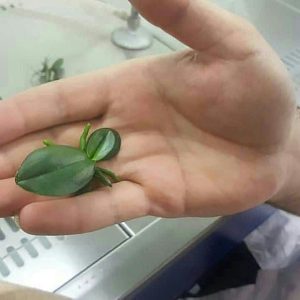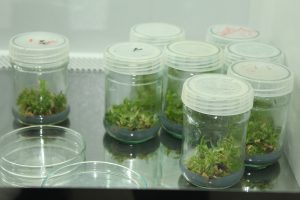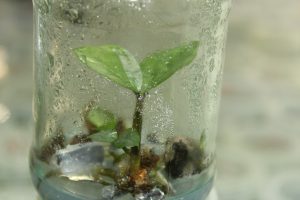Plant tissue culture
Plant tissue culture is a set of techniques used to maintain or grow plant cells, tissues or organs under sterile conditions on a nutrient culture medium of known composition. It is widely used to produce clones of a plant in a method called micropropagation. Various techniques in plant tissue culture may have certain advantages over traditional propagation methods, including:
- In vitro tissue culture of potato explants
- Plant tissue cultures are grown in the USDA Seed Bank, National Center for the Conservation of Genetic Resources.
- Producing exact copies of plants that produce flowers, fruits, or other desirable traits.
- For rapid production of mature plants.
- To produce a large number of plants in a reduced space.
Production of several plants in the absence of seeds or pollinators necessary for seed production.
Regeneration of whole plants from genetically modified plant cells.
The production of plants in sterile containers makes it possible for them to reduce diseases, pests and pathogenic agents.
Producing plants from seeds that otherwise have very little chance of germinating and growing, i.e. orchids and nepenthes.
To clean specific plants from viral infections and rapidly propagate these plants as “clean stocks” for horticulture and agriculture.
Storage of genetic plant material for the protection of native plant species.
Plant tissue culture relies on the fact that many parts of a plant have the ability to regenerate into a whole plant (cells in those regenerating plant parts are called competent cells, which can differentiate into various specialized cells). Single cells, plant cells without cell walls (protoplasts), pieces of leaves, stems or roots can often be used to produce a new plant in culture, depending on the nutrients and plant hormones required.
Techniques used for plant tissue culture in laboratory conditions
Preparation of plant tissue for tissue culture in aseptic conditions and under HEPA filtered air, which is done by slow flow laminar hood. The tissue is then grown in sterile containers, such as petri dishes or flasks, in a growth chamber with controlled temperature and light intensity. Living plant materials from the environment naturally become contaminated with microorganisms on their surfaces (and sometimes their interiors), so their surfaces are disinfected in chemical solutions (usually alcohol and sodium or calcium hypochlorite). Before harvesting, appropriate samples (known as explants) are sterilized.
Sterile explants are usually placed on the surface of a sterile solid culture medium, but sometimes directly into a sterile liquid medium, especially when cell suspension culture is desired. Solid and liquid media generally consist of inorganic salts plus some organic nutrients, vitamins, and plant hormones. Solid media are prepared from liquid media by adding a gelling agent, usually purified agar.
The composition of the medium, especially plant hormones and nitrogen source (nitrate vs. ammonium salts or amino acids) has profound effects on the morphology of tissues growing from the primary explant. For example, excess auxin often results in proliferating roots, while excess cytokinin may produce shoots. Auxin and cytokinin balance often results in disorganized growth of cells or callus, but the growth morphology depends on the plant species as well as the composition of the environment. Fragments are usually cut and subcultured in new media to allow growth or to change the morphology of the media. The skill and experience of the tissue culture expert is very important in the way of cultivation and placement in the environment.
As shoots emerge from a culture, they may be cut and rooted with auxin to produce seedlings that, when mature, can be transplanted into potting soil for further growth in the greenhouse as normal plants.
Specific differences in the regeneration potential of different organs and explants have various explanations. Important factors include differences in the stage of the cells in the cell cycle, the availability or ability to transport endogenous growth regulators, and the metabolic capabilities of the cells. The most common tissue explants are the meristematic ends of plants, such as shoot tips, lateral shoot tips, and root tips. These tissues have a high rate of cell division and concentrate or produce the required growth regulating substances including auxins and cytokinins.
Stem regeneration efficiency in tissue culture is usually a quantitative trait that often varies between plant species and within plant species among subspecies, varieties, cultivars or ecotypes. Therefore, tissue culture reconstitution can become complicated, especially when many reconstitution methods must be established for different genotypes in the same species.
The three common pathways of plant tissue culture regeneration are propagation from pre-existing meristems (stem culture or nodule culture), organogenesis and non-zygotic embryogenesis.
Propagation of shoots or nodal segments is usually done in four steps for mass plantlet production through in vitro vegetative propagation, but organogenesis is a standard method of micropropagation that involves the tissue regeneration of unwanted organs or lateral shoots directly or indirectly from explants. Nonzygotic embryogenesis is a significant developmental pathway that is very comparable to zygotic embryos and is an important pathway for the production of somaclonal types, artificial seed production, and metabolite synthesis. Due to the unicellular origin of non-zygotic embryos, they are preferred in several regeneration systems for micropropagation, ploidy manipulation, gene transfer and artificial seed production. Nevertheless, tissue regeneration through organogenesis is also useful for studying regulatory mechanisms of plant growth.
Pineapple tissue culture
Recent scientific advances in the field of pineapple plant biotechnology have provided new methods for pineapple micropropagation, mass propagation and reduction of production costs. Genetic changes along with micro-propagation have created new varieties of pineapple plants, which, from an economic point of view, are resistant to basic pests and diseases as the most important goals of pineapple biotechnology. Compared to other edible fruits, pineapple has had the least genetic development. Pineapple plant production is based on cultivars available in nature.
Pineapple plant biotechnology operates in 5 different fields:
- Micropropagation of pineapple plants.
- Development of pineapple plant through the development of new genotypes with resistance to pests and diseases.
- Production of plants tolerant to low temperature (below 16 degrees Celsius) and drought.
- Development of fruit hub with high quality and storable.
- Intra- and inter-mollicular transmission of germplasm.
The pineapple plant is a member of the Bromeliaceae or Bromeliad family, which has about 45 genera and 2000 species. In terms of plant classification, it is as follows:
| Eukaryota | Superkingdom |
| Viridiplantae | Kingdom |
| Streptophyta | Subkingdom |
| Embryophyta | Phylum |
| Tracheophyta | Subphylum |
| Magnoliophyta | Superclass |
| Liliopsida | Class |
| Zingiberidae | Subclass |
| Bromeliales | Order |
| Bromeliaceae | Family |
Pineapple was first brought by Christopher Columbus from Europe to Guadalupe Islands in 1493. The people of the island called the pineapple plant pina because of the conical shape of its fruit. Because of the presence of wild pineapple species in the southeastern regions of Brazil, Portugal and northern Argentina, botanists considered these regions to be the primary origin. Based on the obtained evidence, they assumed its primary origin in South America, the more northern regions between the latitudes of 10 degrees north and south and 55 to 75 degrees east. These areas include northeastern and western Brazil, all of Colombia and Guinea, and parts of Venezuela, then pineapples were exported from America to Spain and Portugal and quickly reached Africa and in 1550, they reached South India. Before the end of the 16th century, it was taken to China, Java and the Philippines.
Today, pineapple is spread almost all over the tropical and subtropical regions of the world and its fruit has a great economic value from a commercial point of view.
Cytological and genetic information was obtained from the Pineapple Research Center in Hawaii. By counting the chromosomes of the groups Cayenne, Queen, Spiny Samoa, Ruby, Pernumbuco, Spiny Guatemala (hybrid between the Cayenne group and the unknown wild type from Brazil) and Bromelia pinquin L., it showed that pineapple cultivars with a chromosome number of n=25 and B. pinquin with Chromosome n=48 (Collins 1960).
Breeding and selection objectives in different regions emphasized resistance to disease and pests. Recently, the development of cultivars has been focused on the fleshy part of the fruit.
In Hawaii, advanced hybrid clones derived over many years of breeding are now in the experimental stages of monoculture. In Australia, germplasm sources include selections of “Cayene” clones from Queensland, hybrid populations, meristem cultures of known clones (Winks & Glennie 1981). Hybrid selections are derived from Cayenne crosses with rough-leaved types such as Queen, Ripley Queen, MacGregor, Alexandera and Collard. Singapore Spanich is a thornless plant with good quality fruit and has been widely used in breeding program. He developed the plant identification key of genera and species and the main traits of 5 Cayenne clones. Pineapple isozyme diversity shows 5 genetically diverse groups that were completely consistent with their genetic groupings.
Pineapple is a plant that has lanceolate and dry leaves. These leaves are placed on top of each other and form a narrow channel (vase). These plants grow on long branches and feed on minerals obtained from the dead organic matter of the plant collected in the narrow channel. In fact, growing pineapples is to produce its fruits, and some of them form the most beautiful potted plants. The birthplace of this plant is Brazil. The prickly and leather-like leaves are one after the other so that a hole is created in the middle of the leaves from which the flowering branch appears. It takes 3 to 4 years to bear fruit, and after the appearance and ripening of the fruit, the organ of the mother plant decomposes and dries up, and along with this drying, shoots start to appear from the side of the mother plant.
In the mature plant, the leaf is 30-35 cm long and club-shaped, and its diameter below the apical part is 6.5-7.5 cm. Internodes are short in the range of 1 to 10 mm, which are longer in the middle parts of the stem. There is a lateral bud in each node. Cuttings and scions arise from lateral buds and are used for planting. True cuttings are the aerial organs produced at the apex of the flowering bracts on the peduncle, peduncles are the aerial organs of the lateral buds that give rise to agricultural seedlings. The cuttings are grown continuously until the crop is ripe or until flowering, so they are larger in size than the cuttings. Their weight is 250 to 450 grams and their crown is 100 to 350 grams.


 فارسی
فارسی العربية
العربية




